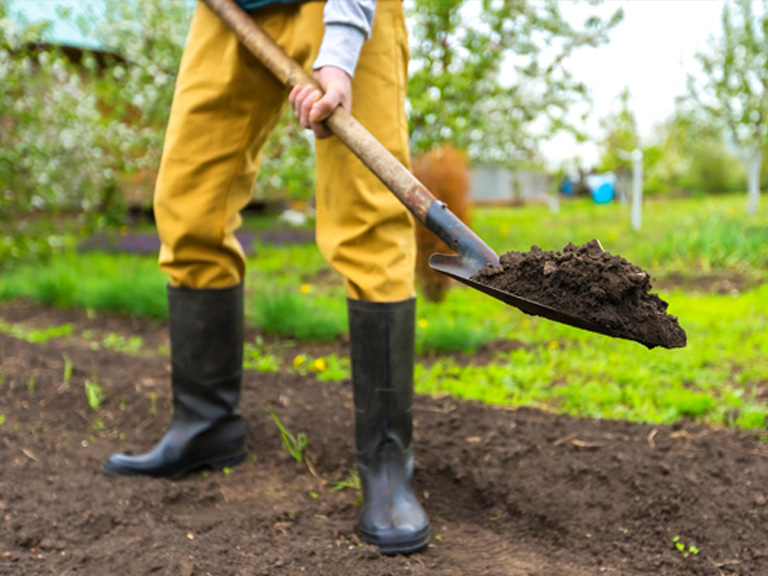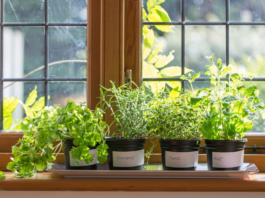Growing Vegetables In Clay Soil: Improving Clay Soil with Gypsum
Growing vegetables in clay soil can be punishing if you scarcely know where to start.
Yes, you can call Clay all the bad names- frustrating, heavy, stubborn and even stupid.
But in my opinion, clay is indeed a fertile growing medium- if you understand how to massage it!
And today, I will show you how to make your garden look like a real garden and not a pottery studio!
Look:
Most people dismiss clay as not good enough for veggie growing.
But in my experience, with a little bit of soothing, clay soil can be insanely friendly to vegetables.
First, here are some tips for clay earth…
SHOP BEST SELLING GARDENING GYPSUM PRODUCTS
Click Here For The Best Gardening Gypsum Products
Top Tips On Handling Clay Soil
- Keep off your clay soil when water-logged. Walking over it –when in a wet state- causes more compaction and ends up making it heavier.
- If possible, put down some wooden boards to step on so that you can distribute your weight evenly.
- Never dig or even plant in wet clay soil.
- The best time to dig over is in the autumn. Incorporating organic matter helps nutrition-wise.
- Leave it in ridges over the winter. Frost will get in and destroy the clumps.
- Planting woody varieties such as trees plus shrubs on small mounds help to keep plant roots clear of deeply wet soil.
Now that you have digested the master tips, let’s move on…
It is true that clay soil has a number of weaknesses that make it look hostile to plant but is it the very worst type of soil for crop planting? Not really. Trust me. There are worse soils! (This will be a story for another day)
Allow me to justify this a bit.
SHOP BEST SELLING GARDENING PRODUCTS
Click Here For The Best Pation & Lawn & Garden Products That Will Save You Time and Money
The Good Side Of Clay Soil
As I said, even the much-maligned clay soil packs some wonderful qualities…
Let’s look at some of them;
- Clay is highly dense. So, it retains moisture very well making it great for some plants.
- It tends to attract more nutrients-than competing soil types. Why?
The particles making it up are negatively charged. So, they pull and collect positively charged minerals such as potassium, calcium, and magnesium.
Can You Believe This?
When crops land on clay, two things are possible:
They either wilt and die right away…
…or they say “Hmmmmh, this taste nice” and hang around.
Actually, some vegetables are at their happiest- when planted on clay! Yep- you heard me right…they would rather hang around;
- Lettuce, snap beans, chard, and all vegetables with shallow roots love clay soils because of high moisture retention.
- Cole crops such as broccoli, Brussels sprouts, and cabbages are fond of clay for its superb root support
- Squash and pumpkins grow almost anywhere. Plant them even when your clay soil is driest and they warmly embrace growth.
For more on this, check out this article on vegetables that grow in clay soil.
SHOP BEST SELLING GARDENING GYPSUM PRODUCTS
Click Here For The Best Gardening Gypsum Products
This Is How You Go About Growing Vegetables In Clay Soil:
Like every other soil, clay also has some negatives:
- Slow draining
- Warms Slowly in spring
- Compacts easily (so plant roots can hardly grow)
- Heaves in winter
- Tends to be alkaline
Now:
To grow your beloved vegetables in clay, you must fight some of the aforementioned negatives..
In short, your success is pegged on whether you succeed in improving it.
So, in this section, I will be showing you how to break down clay soil fast, and also answer one of the most common questions-“how to make clay soil drain better?”
You will also find this useful if you have ever asked “how to amend clay soil for vegetable gardening/?”
Let’s get down to business…
SHOP BEST SELLING GARDENING PRODUCTS
Click Here For The Best Pation & Lawn & Garden Products That Will Save You Time and Money
Improving Clay Soil
For best results, start amending your soil a year before planting…
Step 1:
Cover the chosen ground with around four inches of organic/humus materials- including aged manure, straw, grass clippings, shredded bark, sawdust, and leaves/leaf mold.
Mix both brown and green materials 50:50 to avoid nitrogen/carbon imbalances.
Do this in spring- a year before starting your garden in the subsequent spring.
Remember that humus materials decay quickly and need be added more frequently to see change.
Step 2:
Still on how to break down clay soil in garden, now add 3-4 inches of compost over your layer of organic materials.
Since compost is already broken, it helps to stabilize your clay soil’s structure.
Step 3:
You might have heard about adding sand to clay soil
Well, now distribute 2 inches of rough sand over your compost layer. This increases porosity and drainage.
Fine sand creates a cement-like compound, so only add coarse sand to your clay.
Step 4:
It’s time for the fertilizer- very important especially if your humus materials are not in a 50:50 balance (brown and green).
Take a complete fertilizer, like 12-12-12, and broadcast into your soil. Apply 2 pounds for every 100 square of your garden area.
Step 5:
Till the amended layers of clay soil using a rototiller (at least into the very top 8-10 inches).
Don’t till when wet because it may form difficult-to-break large clods.
Step 6:
Apply more layers of humus/organic materials, compost, and rough sand once per month over the summer.
Similarly, till the amendments again (into the top-most 8-10 inches of your clay soil.
Remember that the rate of your clay soil’s improvement is consistent with the frequency at which you add amendments.
Step 7:
Mid – late fall, scatter seed for a covering crop such as alfalfa, rye, barley, and clover. 1/3 pound of seed should be enough for 100ft2 of garden area.
Your cover crop should be left to grow naturally and untouched over winter. This way, your ground is protected over winter.
The additional humus from your cover also improves the overall soil structure.
SHOP BEST SELLING GARDENING GYPSUM PRODUCTS
Click Here For The Best Gardening Gypsum Products
Step 8:
To further improve your clay soil, add around 2-inches each of your aged manure, finished compost, and coarse sand over your cover crop.
Step 9:
Till your cover crop, and your added amendments roughly 10 inches into your soil.
Do this after all frost has passed (around late winter up to early spring) and when your soil is dry.
Step 10:
You should now break up any remaining soil clods using a spading fork.
Wait 2 weeks for the soil from your clods to dry before tilling your soil for a second time.
Step 11:
Use a leaf rake and a bow rake to rake your ground to its smoothest.
Step 12:
Now, Work your soil into unbending (straight) rows. You will use your garden hoe to create furrows going as deep as your vegetable transplants-specifically, their root balls and which rarely exceed 6 inches.
If you choose to direct sow seed, follow the applicable planting instructions to the latter.
Step 13:
Finally, loosen the soil lying between planting rows using the rototiller. Avoid disturbing the plant roots.
You can even use your garden hoe – to be safe.
This keeps your soil loose and also prevents compaction.
Then, if you can, place some stepping stones in the rows to help minimize foot traffic around your garden, as it can still compact your soil.
SHOP BEST SELLING GARDENING PRODUCTS
Click Here For The Best Pation & Lawn & Garden Products That Will Save You Time and Money
Improving Clay Soil With Gypsum
The above process works- but as you have seen, it will take your time and energy.
Luckily an easier fix would be to apply gypsum- it aerates all clay soils by binding the fine particles found in clay together thus creates clear air channels throughout your soil.
This allows space for vegetable roots to grow. Air and moisture will also move throughout.
How to apply gypsum to clay soil?
Well, let’s see the steps:
Step 1:
Setup your lawn spreader or even a hand-held/manual garden spreader to exactly 40 pounds per 1000ft2 for current lawns or gardens.
For unplanted soil, it should be set to 20-30 pounds per one thousand square feet.
Then take granulated gypsum and add to your spreader hopper till the gypsum tops the fill line.
Step 2:
Spread the added gypsum evenly all over your targeted surface- even over plants since it doesn’t harm them
Step 3:
Add compost or any organic matter to your garden soil then Mix with your gypsum using a rake or a hoe.
Step 4:
Water the gypsum with your garden hose or sprinkler into the soil. Remember to clean your spreader as necessary
So, how long does gypsum take to work?
While your clay soil will start improving within a few months, apply it each year for a minimum of 3 years.
That will give you the very best results.
SHOP BEST SELLING GARDENING GYPSUM PRODUCTS
Click Here For The Best Gardening Gypsum Products
Wrapping It Up
So, have you seen how to loosen clay soil? And that growing vegetables in clay soil is very possible?
It Simple – just answer the question “how to improve clay soil for vegetable garden?” and you are ready to go.
Lastly, do you have more tips on how to break down clay soil in garden? Feel free to share with our readers by leaving a comment!
Click Here For The Best Gardening Gypsum Products
SHOP BEST SELLING GARDENING PRODUCTS
Click Here For The Best Pation & Lawn & Garden Products That Will Save You Time and Money




